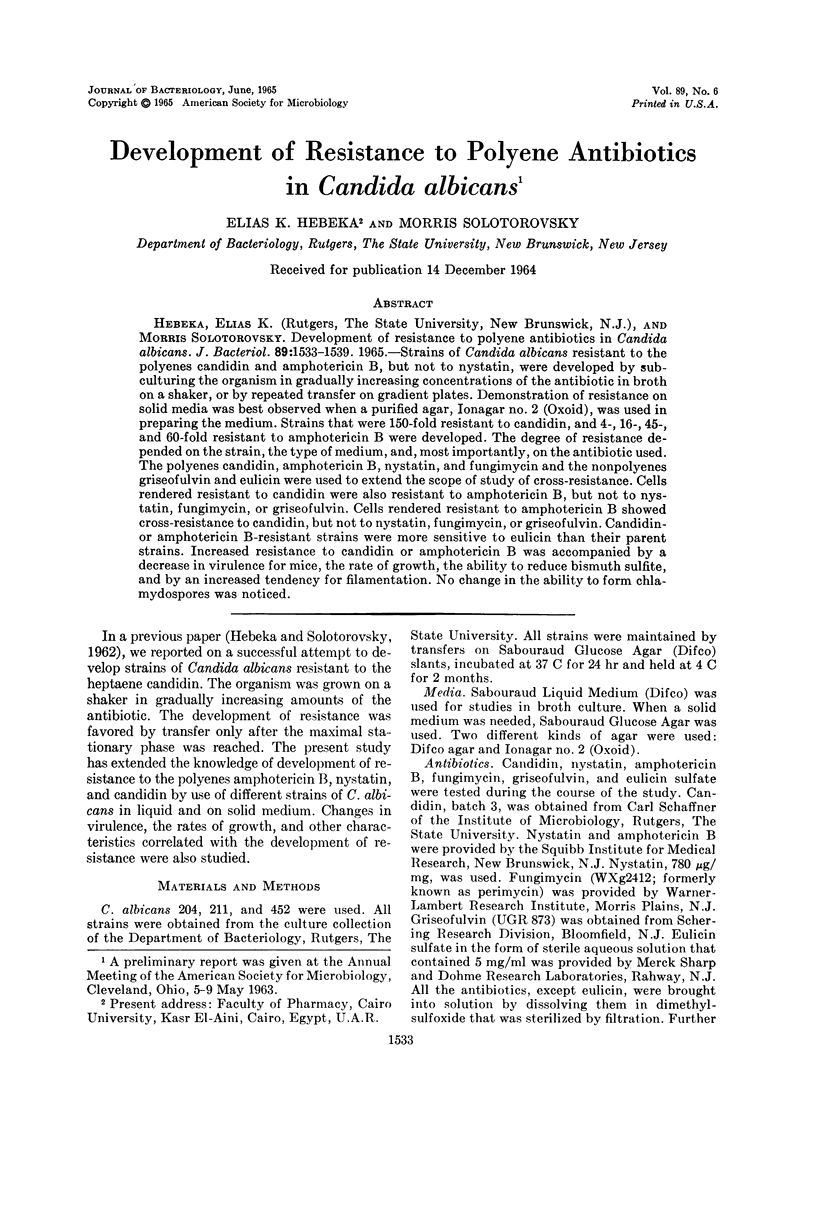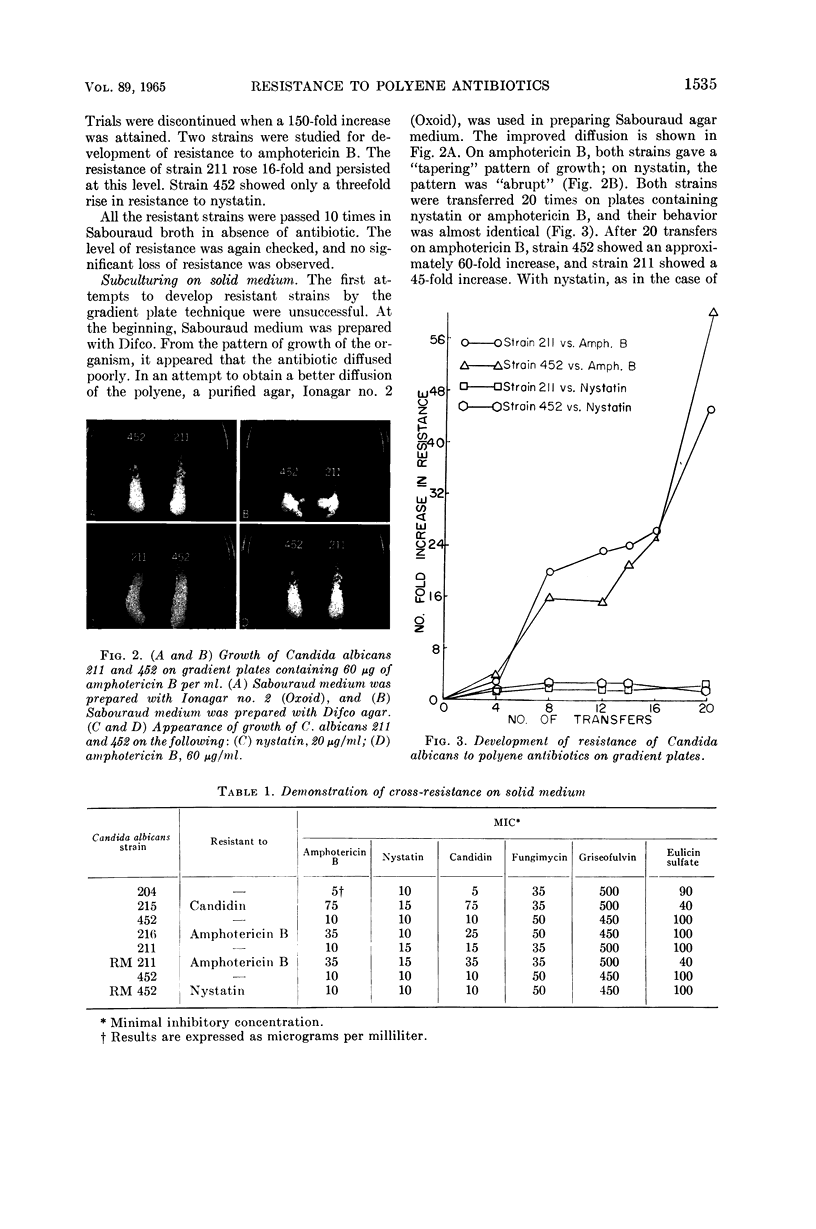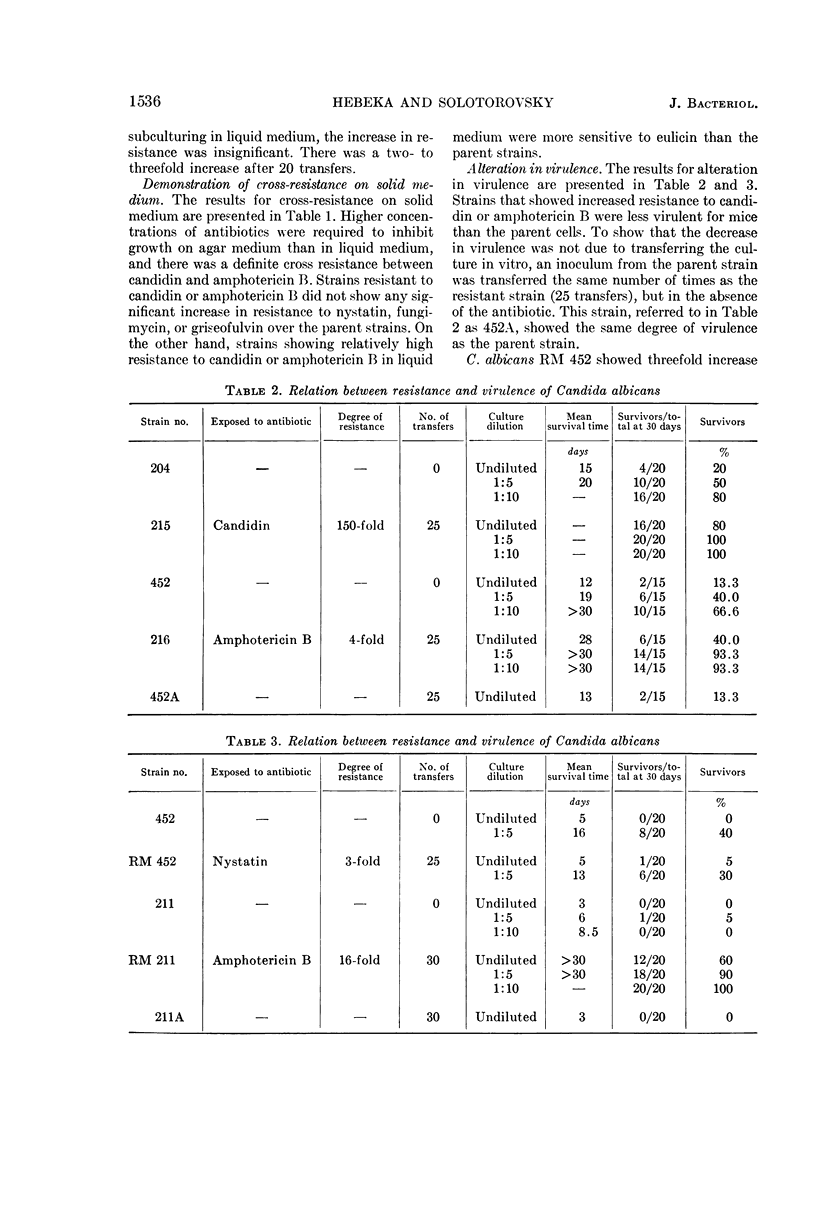Abstract
Hebeka, Elias K. (Rutgers, The State University, New Brunswick, N.J.), and Morris Solotorovsky. Development of resistance to polyene antibiotics in Candida albicans. J. Bacteriol. 89:1533–1539. 1965.—Strains of Candida albicans resistant to the polyenes candidin and amphotericin B, but not to nystatin, were developed by sub-culturing the organism in gradually increasing concentrations of the antibiotic in broth on a shaker, or by repeated transfer on gradient plates. Demonstration of resistance on solid media was best observed when a purified agar, Ionagar no. 2 (Oxoid), was used in preparing the medium. Strains that were 150-fold resistant to candidin, and 4-, 16-, 45-, and 60-fold resistant to amphotericin B were developed. The degree of resistance depended on the strain, the type of medium, and, most importantly, on the antibiotic used. The polyenes candidin, amphotericin B, nystatin, and fungimycin and the nonpolyenes griseofulvin and eulicin were used to extend the scope of study of cross-resistance. Cells rendered resistant to candidin were also resistant to amphotericin B, but not to nystatin, fungimycin, or griseofulvin. Cells rendered resistant to amphotericin B showed cross-resistance to candidin, but not to nystatin, fungimycin, or griseofulvin. Candidinor amphotericin B-resistant strains were more sensitive to eulicin than their parent strains. Increased resistance to candidin or amphotericin B was accompanied by a decrease in virulence for mice, the rate of growth, the ability to reduce bismuth sulfite, and by an increased tendency for filamentation. No change in the ability to form chlamydospores was noticed.
Full text
PDF






Images in this article
Selected References
These references are in PubMed. This may not be the complete list of references from this article.
- HEBEKA E. K., SOLOTOROVSKY M. Development of strains of Candida albicans resistant to candidin. J Bacteriol. 1962 Aug;84:237–241. doi: 10.1128/jb.84.2.237-241.1962. [DOI] [PMC free article] [PubMed] [Google Scholar]
- LAMPEN J. O., MORGAN E. R., SLOCUM A., ARNOW P. Absorption of nystatin by microorganisms. J Bacteriol. 1959 Aug;78:282–289. doi: 10.1128/jb.78.2.282-289.1959. [DOI] [PMC free article] [PubMed] [Google Scholar]
- LITTMAN M. L., PISANO M. A., LANCASTER R. M. Induced resistance of Candida species to nystatin and amphotericin B. Antibiot Annu. 1957;5:981–987. [PubMed] [Google Scholar]
- LONES G. W., PEACOCK C. L. Alterations in Candida albicans during growth in the presence of amphotericin B. Antibiot Chemother (Northfield) 1959 Sep;9:535–540. [PubMed] [Google Scholar]
- MACDONALD E. M., WEGNER M. J. A slide culture technique for the identification of Candida albicans. Tex Rep Biol Med. 1962;20:128–130. [PubMed] [Google Scholar]
- NICKERSON W. J., FALCONE G. ENZYMATIC REDUCTION OF SELENITE. J Bacteriol. 1963 Apr;85:763–771. doi: 10.1128/jb.85.4.763-771.1963. [DOI] [PMC free article] [PubMed] [Google Scholar]
- NICKERSON W. J., MANKOWSKI Z. A polysaccharide medium of known composition favoring chlamydospore formation in Candida albicans. J Infect Dis. 1953 Jan-Feb;92(1):20–25. doi: 10.1093/infdis/92.1.20. [DOI] [PubMed] [Google Scholar]
- NICKERSON W. J. Reduction of inorganic substances by yeasts. I. Extracellular reduction of sulfite by species of Candida. J Infect Dis. 1953 Jul-Aug;93(1):43–56. doi: 10.1093/infdis/93.1.43. [DOI] [PubMed] [Google Scholar]
- PAGANO J. F., STOUT H. A. Resistance studies with nystatin. Antibiot Annu. 1955;3:704–710. [PubMed] [Google Scholar]
- SORENSEN L. J., McNALL E. G., STERNBERG T. H. The development of strains of Candida albicans and Coccidioides immitis, which are resistant to amphotericin B. Antibiot Annu. 1958;6:920–923. [PubMed] [Google Scholar]
- VINING L. C. The polyene antifungal antibiotics. Hindustan Antibiot Bull. 1960 Nov;3:37–54. [PubMed] [Google Scholar]




